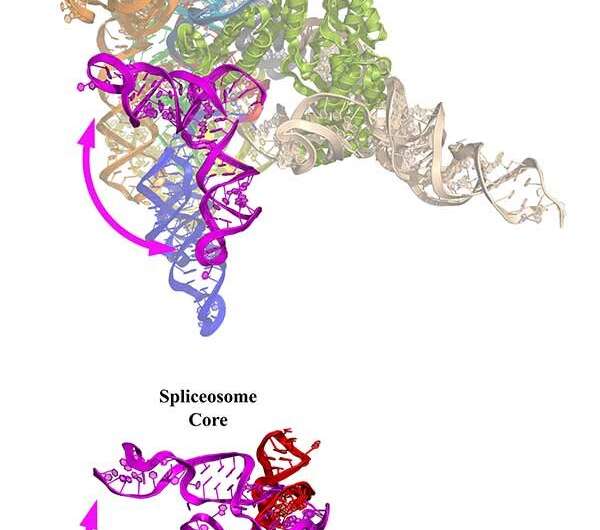Like film editors and archaeologists, biochemists piece together genome history

Old-school Hollywood editors cut unwanted frames of film and patched in desired frames to make a movie. The human body does something similar—trillions of times per second—through a biochemical editing process called RNA splicing. Rather than cutting film, it edits the messenger RNA that is the blueprint for producing the many proteins found in cells.
In their exploration of the evolutionary origins and history of RNA splicing and the human genome, UC San Diego biochemists Navtej Toor and Daniel Haack combined two-dimensional (2-D) images of individual molecules to reconstruct a three-dimensional (3-D) picture of a portion of RNA—what the scientists call group II introns. In so doing, they discovered a large-scale molecular movement associated with RNA catalysis that provides evidence for the origin of RNA splicing and its role in the diversity of life on Earth. Their breakthrough research is outlined in the current edition of Cell.
"We are trying to understand how the human genome has evolved starting from primitive ancestors. Every human gene has unwanted frames that are non-coding and must be removed before gene expression. This is the process of RNA splicing," stated Toor, an associate professor in the Department of Chemistry and Biochemistry, adding that 15 percent of human diseases are the result of defects in this process.
Toor explained that his team works to understand the evolutionary origins of 70 percent of human DNA—a portion made up of two types of genetic elements, which are both thought to have evolved from group II introns. Specifically, spliceosomal introns, which make up about 25 percent of the human genome, are non-coding sequences that must be removed before gene expression. The other 45 percent is comprised of sequences derived from what are called retroelements. These are genetic elements that insert themselves into DNA and hop around the genome to replicate themselves via an RNA intermediate.
"Studying group II introns gives us insight into the evolution of a large portion of the human genome," noted Toor.
Working with the group II intron RNA nanomachine, Toor and Haack, a postdoctoral scholar at UC San Diego and first author of the paper, were able to isolate the group II intron complexes from a species of blue-green algae that lives at high temperature.
"Using a group II intron from a high-temperature organism facilitated structure determination due to the innate stability of the complex from this species," said Haack. "The evolution of this type of RNA splicing likely led to the diversification of life on Earth."
Haack further explained that he and Toor discovered that the group II intron and the spliceosome share a common dynamic mechanism of moving their catalytic components during RNA splicing.
"This is the strongest evidence to date that the spliceosome evolved from a bacterial group II intron," he said.
Additionally, the findings reveal how group II introns are able to insert themselves into DNA through a process called retrotransposition. This copy-and-paste process has resulted in selfish retroelements proliferating in human DNA to comprise a large portion of the genome.
"Replication of these retroelements has played a large role in shaping the architecture of the modern human genome and has even been implicated in the speciation of primates," noted Toor.
The researchers used cryo-electron microscopy (cryo-EM) to extract a molecular structure of the group II intron. They froze the RNA in a layer of thin ice and then shot electrons through this sample. According to the scientists, the electron microscope can magnify the image 39,000 times. The resulting 2-D images of individual molecules were then put together to come up with a 3-D view of the group II intron.
"This is like molecular archaeology," described Haack. "Group II introns are living fossils that give us a glimpse into how complex life first evolved on Earth."
More information: Daniel B. Haack et al, Cryo-EM Structures of a Group II Intron Reverse Splicing into DNA, Cell (2019). DOI: 10.1016/j.cell.2019.06.035
Journal information: Cell
Provided by University of California - San Diego


















